
Soul Edge is a fighting game developed by the Namco team Project Soul and published by Namco as the first installment in the Soulcalibur series of 3D fighting games. Introduced at the JAMMA trade show in November 1995, the full arcade game was released in early 1996, while later in December an upgraded and expanded version of the game was ported to the PlayStation. The PlayStation version was renamed Soul Blade in North America, Europe, and Australia.
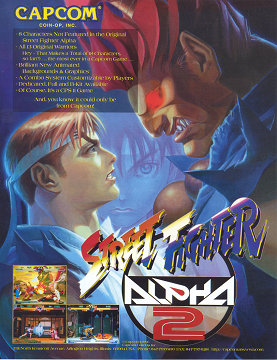
Street Fighter Alpha 2, known as Street Fighter Zero 2 in Japan, Asia, South America, and Oceania, is a 1996 fighting game originally released for the CPS II arcade hardware by Capcom. The game is a remake to the previous year's Street Fighter Alpha: Warriors' Dreams. The game features a number of improvements over the original, such as new attacks, stages, endings, and gameplay features. It was followed by Street Fighter Alpha 3.

Tech Romancer is a 1998 3D fighting arcade game by Capcom that draws heavily from the various subgenres of mecha anime. It was later ported to the Dreamcast console. The player controls a giant robot which is used to fight another robot in one-on-one combat. Studio Nue designed the robots in this game.

Zone of the Enders, officially abbreviated as Z.O.E., is a 2001 third-person shooter hack-and-slash video game that was developed and published by Konami for the Sony PlayStation 2. The game is based around mecha combat in outer space. Over the course of the game, the player obtains new weapons and has to protect towns from enemies.

Dead or Alive 2 is a fighting game developed by Team Ninja and published by Tecmo. It debuted in Arcades in 1999 and was later ported for the Dreamcast and the PlayStation 2 in 2000. It is the second main entry in the Dead or Alive fighting series. Several enhanced editions of the game were released, including the updates Dead or Alive 2 Millennium and Dead or Alive 2 Hardcore.

Vampire Hunter D is a PlayStation video game based on the series of books and movies of the same name. Along with Countdown Vampires, it is one of the few survival horror games to revolve around vampires.

Ninety-Nine Nights stylized as N3: Ninety-Nine Nights, is a 2006 fantasy hack and slash video game developed for the Xbox 360 by an alliance between Q Entertainment and Phantagram; video game designer Tetsuya Mizuguchi served as producer for the game. The game features hundreds of enemies onscreen at any given time, and borrows heavily from other video games of the genre, most notably from the Dynasty Warriors and Kingdom Under Fire series.
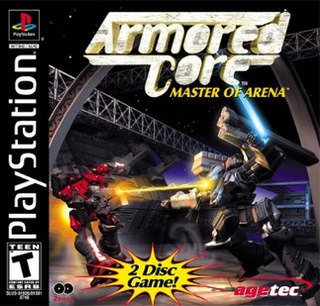
Armored Core: Master of Arena is a 1999 third-person shooter mecha video game developed by FromSoftware for the PlayStation. Master of Arena is the third entry in the Armored Core series and a direct sequel to Armored Core: Project Phantasma. It is the final game in the original Armored Core trilogy. The game was not released in Europe. An indirect sequel, Armored Core 2, was released on August 3, 2000, for the PlayStation 2.
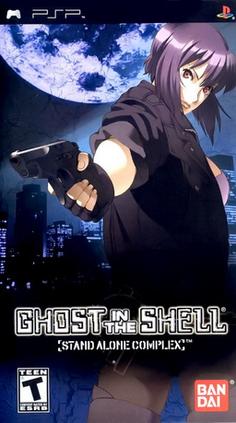
Ghost in the Shell: Stand Alone Complex, released in Japan as Kokaku Kidotai: Stand Alone Complex - Domain of the Hunters, is a first-person shooter video game based on the cyberpunk anime series Ghost in the Shell: Stand Alone Complex and a sequel to the first Ghost in the Shell: Stand Alone Complex game of the same title, developed by G-Artists and published for the PlayStation Portable by Sony Computer Entertainment and Bandai in 2005. It was released in Japan on September 15, 2005, in Europe on October 21, 2005 distributed by Atari Europe, and in North America on October 26, 2005, but releasing it under the same name as the original PS2 game caused confusion and misinterpretation of it as a port.
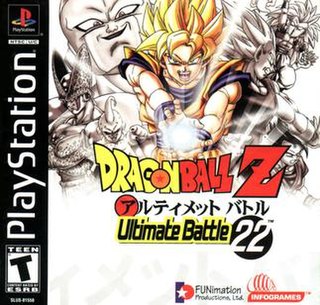
Dragon Ball Z: Ultimate Battle 22 is a 1995 fighting video game developed by Tose and published by Bandai and Infogrames for the PlayStation. Based upon Akira Toriyama's Dragon Ball franchise, its gameplay is similar to the Super Butōden sub-series, consisting of one-on-one fights with a main six-button configuration, featuring special moves, as well as five playable modes. It is referred as "Ultimate Battle 22" or "UB22" by fans due to the roster of twenty two playable characters from the series.
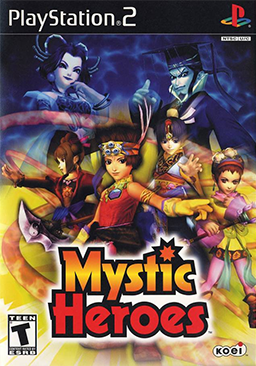
Mystic Heroes is a hack and slash video game developed by Koei. The game is loosely based on Investiture of the Gods, a Chinese supernatural novel about the fall of the Shang Dynasty and the rise of the Zhou Dynasty.

Cyber Troopers Virtual-On MARZ is a 3D Mecha action-adventure game developed by Hitmaker and published by Sega. The game was first released on the PlayStation 2 in North America and Japan, and is the fourth game in the Virtual On franchise. MARZ expands upon the basic gameplay rules of Virtual-On Force, and reuses most of the game's assets; from the stages down to models of the Virtuaroids, the game's enemies.

Fatal Fury: Wild Ambition is a 3D fighting video game produced by SNK and is a spin-off of the Fatal Fury series of fighting games. The game was released in Japanese arcades on January 28, 1999. It was one of the last games released for the Hyper Neo Geo 64 system board. It was ported to the Sony PlayStation on June 24 in Japan and November 30 in North America, making it the only Hyper Neo Geo 64 game to receive a port for a home system. The game was re-released as a downloadable game for PlayStation 3 and PlayStation Portable via the PlayStation Network in Japan on April 25, 2007.

Freaky Flyers is an air racing video game developed internally by Midway San Diego for the Xbox and PlayStation 2, while the version for the GameCube was developed by Point of View, Inc. and published by Midway.

Advance Guardian Heroes is a beat 'em up video game developed by Treasure for the Game Boy Advance. The game was released on September 22, 2004, in Japan, September 14 in North America and February 18, 2005, in Europe. The Japanese version was self-published by Treasure, while the American and European editions of the game are published by Ubisoft.
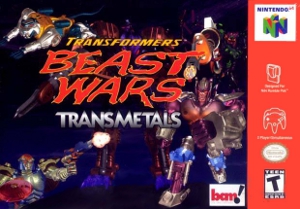
Transformers: Beast Wars Transmetals is a 1999 3D fighting game based on the Transformers: Beast Wars cartoon series and toy-line for the Nintendo 64 and PlayStation. Each version features different mechanics and playable characters.
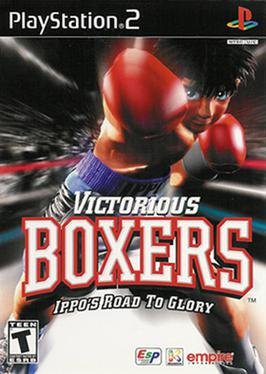
Victorious Boxers: Ippo's Road to Glory, known as simply Victorious Boxers, is a boxing video game developed by New Corporation for the PlayStation 2 video game console. It is based on the Hajime no Ippo franchise. The game was released in Japan by Entertainment Software Publishing in December 2000 and in North America and Europe by Empire Interactive in 2001.

JoJo's Bizarre Adventure is a fighting video game developed by Capcom based on Hirohiko Araki's manga of the same title. The game was developed by the same team who was responsible for the Street Fighter III series.

Dragon Ball Z: Budokai Tenkaichi, released in Japan as Dragon Ball Z: Sparking!, is a series of fighting games developed by Spike based on the Dragon Ball manga series by Akira Toriyama. The series was published by Namco Bandai Games in Japan and Europe, and by Atari in North America and Australia until 2008. Since Budokai Tenkaichi 3, Bandai Namco has handled Dragon Ball game publishing in all regions, effectively ending Atari's involvement.

Saint Seiya: Brave Soldiers is a video game developed by Dimps and Bandai Namco Entertainment featuring the characters and story of Masami Kurumada's Saint Seiya manga. It was released for the PlayStation 3 on October 17, 2013 in Japan, November 21, 2013 in Australia, November 22, 2013 in Europe and November 26, 2013 in North America, and it is also the first Saint Seiya game to be released in North America.




















